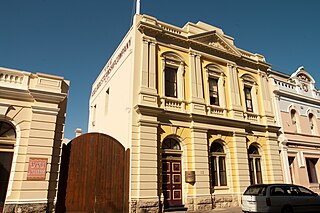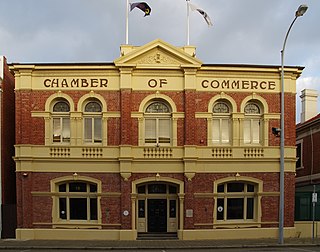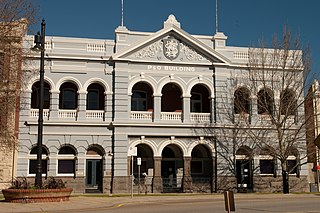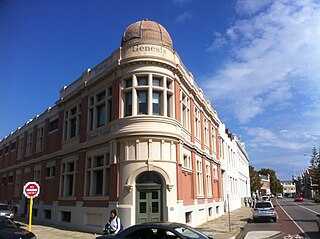
The Adelaide Steamship House is located at 10-12 Mouat Street, Fremantle. Built in 1900, the building was designed by Fremantle-based architectural firm Charles Oldham and Herbert Eales and was constructed by C. Coghill. The building takes its name from the original owners of the building, the Adelaide Steamship Company, who provided sea passenger and freight services around Australia.

WD Moore & Co Warehouse complex is on Henry Street, Fremantle. It was unified in 1899 behind an ornamental stucco facade. A store was established on the site by Samuel Moore in the 1840s. William Dalgety Moore later established a general merchant business there in 1862. The complex comprises a residence, warehouse, factory stable, offices and shop, built between 1862 and 1899, in addition to a three-storey backstore which was built at an unknown date, possibly as early as 1844. The complex was listed on the Register of the National Estate in 1978.

The Fremantle Chamber of Commerce is a business and commerce advocacy association in Fremantle, Western Australia.

Mouat Street is a 300-metre-long (980 ft) street in Fremantle, Western Australia. Historically, the name was often spelled as Mouatt Street.

The National Hotel is on the corner of High and Market Streets Fremantle. Originally built as a shop in 1868, it was occupied by the National Bank in the early 1880s. When the bank relocated in 1886, the building became the National Hotel.

The former P&O Building, also known as the Australian Union Steamship Navigation Company building, is a heritage-listed building in Phillimore Street in the west end of Fremantle, Western Australia.

The Dalgety Offices is a heritage-listed office building at 1-13 Sturt Street, Townsville CBD, City of Townsville, Queensland, Australia. It was designed by Walter Hunt and built from 1923 to 1925 by William Hornby Turner. It is also known as Sunskill House. It was added to the Queensland Heritage Register on 26 August 2005.
Cliff Street is a street in Fremantle, Western Australia. It is the furthest west cross street on High Street, running parallel to Mouat Street. It is also at the south western edge of University of Notre Dame campus buildings. It is part of the Fremantle West End Heritage area, which was established in late 2016.

Phillimore Street is a street in Fremantle, Western Australia; it runs between Queen Street, outside the Fremantle railway station and Cliff Street.

Fremantle West End Heritage area is a designated heritage precinct in Fremantle, Western Australia.

Central Chambers is a heritage listed building located at 61-63 High Street on the corner of Pakenham Street in Fremantle, Western Australia. It was one of many commercial buildings constructed in Fremantle during the gold boom period in the late nineteenth and early twentieth century.

The P&O Hotel is a heritage listed building located at 25 High Street on the corner of Mouat Street in Fremantle, Western Australia. It was one of many commercial buildings constructed in Fremantle during the gold boom period in the late nineteenth and early twentieth century.

The former Union Bank of Australia Building, also known as the ANZ Bank Building, is a heritage listed building located at 86 High Street in the Fremantle West End Heritage area. It was one of many commercial buildings constructed in Fremantle during the interwar period.

Beach Street in a street located in Fremantle, Western Australia. It runs along the historic southern shore of the Swan River, south-east of the inner harbour, between Parry Street and East Street.

The Evan Davies Building, also known as the Literary Institute Building, is a heritage listed building located at 13 South Terrace, Fremantle, Australia, on the corner with Collie Street. It was one of many buildings constructed in Fremantle during the gold boom period in the late nineteenth and early twentieth century.

Fremantle Woolstores were at least four large buildings on the southern side of Fremantle Harbour, in Fremantle, Western Australia.

Owston's Buildings, also known as Ouston's building, is a heritage listed building located at 9-23 High Street on the corner with Mouat Street in the Fremantle West End Heritage area. It was one of many buildings constructed in Fremantle during the gold boom period in the late nineteenth and early twentieth century.

The former Tarantella Night Club building, also known as the German Consulate and Norddeutscher-Lloyd Building is a heritage building located at Mouat Street in the Fremantle West End Heritage area. The building dates from the gold rush boom period in the late nineteenth and early twentieth centuries and is of historic significance.

The Robert Harper Building, also known as Jebsens, is a heritage-listed building located at 49 Phillimore Street, on the corner of Pakenham Street in the Fremantle West End Heritage area. It is one of many commercial buildings constructed in Fremantle during the gold boom period in the late nineteenth and early twentieth century.

Liner House is a heritage-listed office building located at 13–15 Bridge Street, in the Sydney central business district, in the City of Sydney local government area of New South Wales, Australia. It was designed by Bunning and Madden and built from 1959 to 1960. It is also known as Moran House. It houses a restaurant and the Moran Arts Foundation on its lower floors. It was added to the New South Wales State Heritage Register on 2 April 1999. The building was awarded the Sir John Sulman Medal in 1961.
























